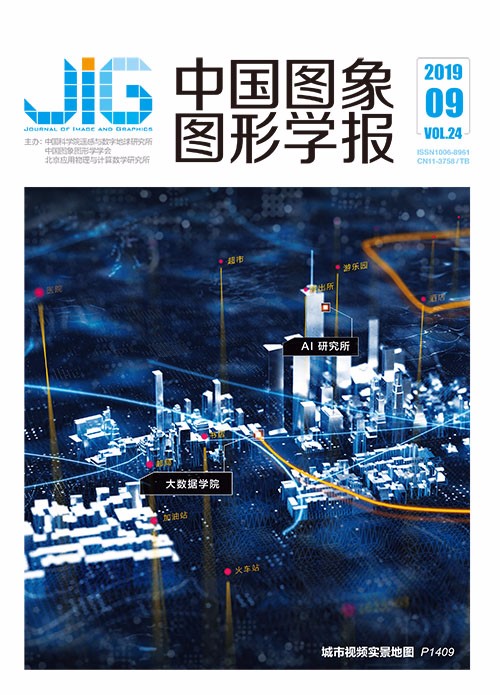
增强边缘梯度特征局部量化策略驱动下的车标识别
摘 要
目的 车标是车辆的显著性特征,通过车标的分类与识别可以极大缩小车辆型号识别的范围,是车辆品牌和型号识别中的重要环节。基于特征描述子的车标识别算法存在如下缺点:一方面,算法提取的特征数量有限,不能全面描述车标的特征;另一方面,提取的特征过于冗杂,维度高,需要大量的计算时间。为了提取更加丰富的车标特征,提高识别效率,提出一种增强边缘梯度特征局部量化策略驱动下的车标识别方法。方法 首先提取车标图像的增强边缘特征,即根据不同的梯度方向提取梯度信息,生成梯度大小矩阵,并采用LTP(local ternary patterns)算子在梯度大小矩阵上进一步进行特征提取,然后采用特征码本对提取的特征进行量化操作,在确保车标特征描述能力的同时,精简了特征数目,缩短了局部向量的长度,最后采用WPCA(whitened principal component analysis)进行特征降维操作,并基于CRC(collaborative representation based classification)分类器进行车标的识别。结果 基于本文算法提取的车标特征向量,能够很好地描述车标图像的特征,在HFUT-VL1车标数据集上取得了97.85%的识别率(平均每类训练样本为10张),且在识别难度较大的XMU车标数据集上也能取得90%以上的识别率(平均每类训练样本为100张),与其他识别算法相比,识别率有明显提高,且具有更强的鲁棒性。结论 增强边缘梯度特征局部量化策略驱动下的车标识别算法提取的特征信息能够有效地描述车标,具有很高的识别率和很强的鲁棒性,大大降低了特征向量的维度,提高了识别效率。
关键词
Vehicle logo recognition based on local quantization of enhanced edge gradient features
Yu Ye1,2, Xu Jingtao1,2, He Minxue1,2, Lu Qiang1,2(1.School of Computer Science and Information Engineering, Hefei University of Technology, Hefei 230009, China;2.Anhui Province Key Laboratory of Industry Safety and Emergency Technology, Hefei 230009, China) Abstract
Objective The comprehensive perception of traffic management through computer vision technology is particularly important in intelligent transportation systems (ITSs). As the core element of ITSs, vehicles are important objects of perception. Vehicle logos carry important information that benefits vehicle information collection, vehicle identification, and illegal vehicle tracking. As logos are distinctive features of any vehicle, their classification and recognition can also greatly narrow the scope of vehicle model recognition. However, traditional feature descriptor-based vehicle logo recognition methods have the following disadvantages. On the one hand, the number of features extracted is limited; thus, the characteristics of vehicle logos cannot be fully described. On the other hand, the extracted features are extremely complicated and highly dimensional. These traditional methods thus entail substantial computation time and are difficult to apply to actual vehicle identification-related systems. A vehicle logo recognition method based on local quantization of enhanced edge gradient features is proposed in this work to extract abundant vehicle logo image features while effectively reducing feature dimensions to improve recognition efficiency. Method First, the characteristics of vehicle logo images are considered, and the edge gradient is used to represent vehicle logos. The gradient information of the vehicle logo images is extracted by calculating the gradient information of each pixel in each vehicle logo image and dividing the gradient information according to the gradient direction. The sum of the gradient magnitudes corresponding to different gradient directions in the neighborhood of each pixel is calculated to generate a gradient magnitude matrix of different directions. Then, the LTP (local tarnary patterns) descriptor is used to re-extract features from the gradient magnitude matrix. The LTP descriptor has stronger anti-noise capability than LBP (local binary patterns) and can generate features with greater robustness. The extracted features belonging to different direction gradients are concatenated, and the results serve as the final feature for each vehicle logo. Second, the K-means method is used to cluster the vehicle logo samples to generate feature codebooks, which are used to represent various types of vehicle logos. Feature codebooks can simplify the features extracted, thereby minimizing the number of features of vehicle logos for feature vector dimension reduction. A low dimension can reduce computational cost while facilitating the classification and recognition of vehicle logo images. Finally, the CRC (collaborative representation based classification) classifier is used to classify and identify the vehicle logo images. Result The characteristics of vehicle logo images can be described on the basis of the features obtained by the proposed method. The edge information of vehicle logos is effectively extracted by dividing the gradient into several directions and using the LTP descriptor to re-extract features. The quantization of features quantizes millions of extracted features into dozens of representative ones to greatly reduce the dimension of features. The proposed method achieves a high average recognition rate of 97.85% on the HFUT-VL1 dataset with 10 training samples. Experimental results show that compared with those of other traditional methods, the recognition rate of the proposed method is significantly improved, with such rate being 2.32 percentage higher than those of the patterns of oriented edge magnitudes algorithm and the histogram of oriented gradients based on gradient direction. In the recognition of 80 types of vehicle logos, the proposed method presents minimal fluctuations and can achieve high recognition rates for all types. Even for several logos with high recognition difficulty, the recognition rates of the proposed method are higher than those of other gradient-based recognition methods. In addition, the experimental results on the XMU dataset show that our method is robust. Conclusion The proposed vehicle logo recognition algorithm based on the local quantization of enhanced edge gradient features can capture the characteristics of vehicle logo images and effectively obtain the edge information of vehicle logos. The proposed algorithm features good robustness and compactness. The proposed method can also achieve higher recognition rates, less fluctuation recognition curves for all types of vehicle logs, and smaller standard deviations than other classical recognition methods. At the same time, the feature quantization of the proposed method greatly simplifies the number of features while retaining the information of vehicle logos. In this way, the proposed method is conducive to classification and recognition. In conclusion, the local quantization of the enhanced edge gradient feature-based recognition method is more suitable for vehicle logo recognition and can achieve better results than several other state-of-art methods.
Keywords
vehicle logo recognition gradient feature multiple gradient direction enhanced edge gradient feature local quantization
|



 中国图象图形学报 │ 京ICP备05080539号-4 │ 本系统由
中国图象图形学报 │ 京ICP备05080539号-4 │ 本系统由